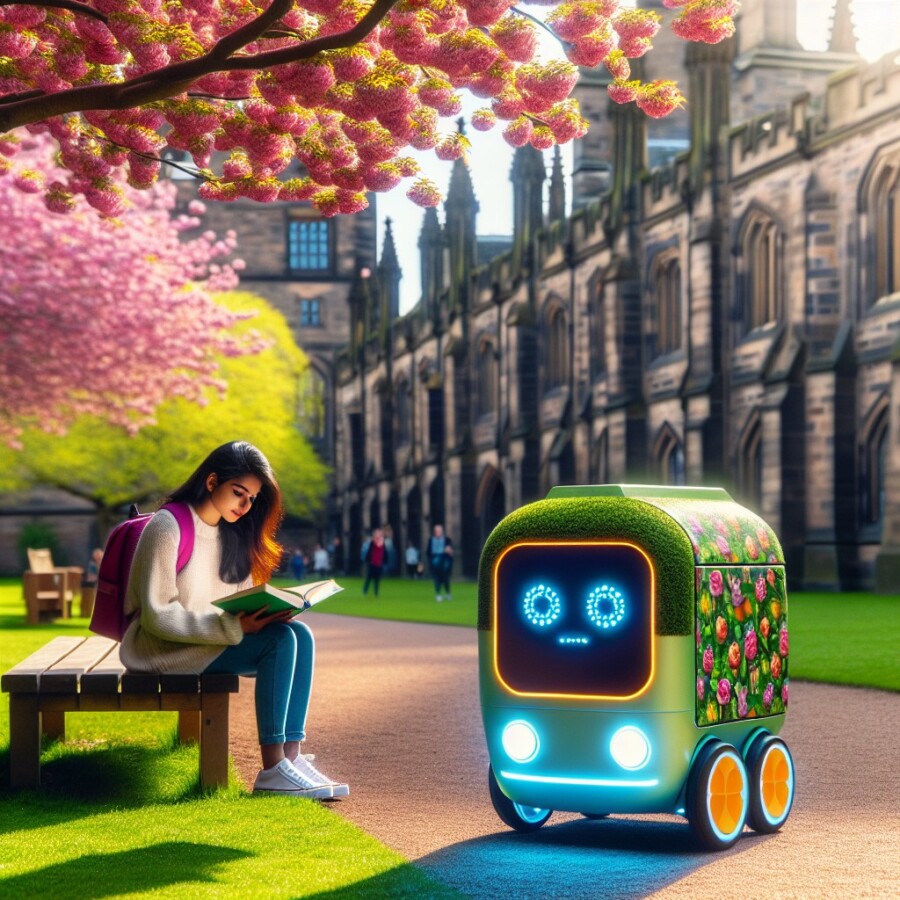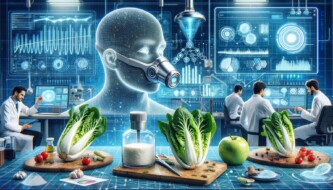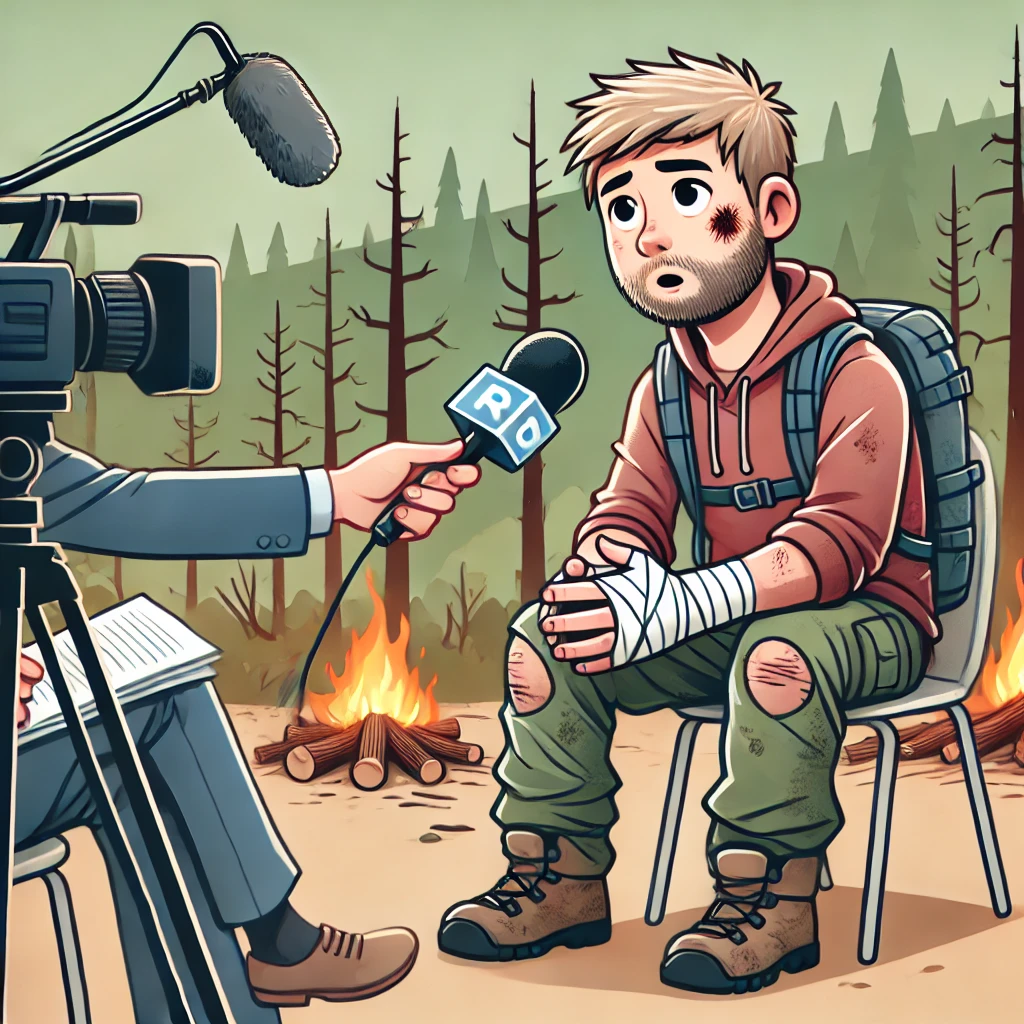At the University of Edinburgh, they’re testing out a cool project where robots deliver food to students. These robots, called Pixie, can drive around on special roads within the campus. Students can order food using an app on their phones, and the robots bring it right to them. The goal of this project is to show how useful robots can be in places like airports or hospitals.
BBC Scotland News recently visited the University of Edinburgh to check out these food delivery robots. The scientists at the university have been working hard to make this technology possible. In the video, they show how the robots bring takeout food to students, and talk about how they could be used in other places too.
The project is all about showing that robots can be used to deliver food. Students can use an app to order their food, and the Pixie robots bring it to them. This could change the way food is delivered, not just on campuses, but also in places like airports or hospitals.
The video asks if this technology is close to becoming a reality. While there are still some challenges to figure out, the progress made so far is really promising. It looks like we’re getting closer to a future where robots are delivering food and other things to us.
Original news source: The robots delivering takeaways to Edinburgh students (BBC)
🎧 Listen:
Slow
Normal
Fast
📖 Vocabulary:
| 1 | project | A planned series of activities to achieve a goal |
| 2 | robots | Machines that can perform tasks automatically |
| 3 | deliver | To bring something to a place |
| 4 | campus | The grounds and buildings of a university or college |
| 5 | app | A software application for mobile devices |
| 6 | technology | The use of scientific knowledge for practical purposes |
| 7 | scientists | People who study and experiment in different fields of science |
| 8 | takeout | Food ordered from a restaurant to eat elsewhere |
| 9 | challenges | Difficult situations that need to be dealt with |
| 10 | progress | The advancement or development towards a better state |
| 11 | promising | Showing signs that something will likely be successful or effective |
| 12 | future | What is expected to happen or exist in time to come |
| 13 | airports | Places where airplanes take off and land |
| 14 | hospitals | Medical facilities where people receive treatment |
| 15 | reality | The actual existence of something |
Group or Classroom Activities
Warm-up Activities:
– News Summary
Instructions:
1. Divide the class into pairs or small groups.
2. Have each group read the article together.
3. Instruct the groups to summarize the main points of the article in a few sentences.
4. Give each group a few minutes to discuss and write their summary.
5. Have each group share their summary with the class.
– Opinion Poll
Instructions:
1. Divide the class into pairs or small groups.
2. Have each group discuss their opinions on the use of robots for food delivery.
3. Provide a list of questions for the groups to answer, such as “Do you think using robots for food delivery is a good idea? Why or why not?”
4. Instruct the groups to write down their answers and discuss their reasoning.
5. After a few minutes, have each group share their opinions with the class.
– Vocabulary Pictionary
Instructions:
1. Write a list of key vocabulary words from the article on the board.
2. Divide the class into pairs or small groups.
3. Have each group take turns choosing a word from the list.
4. Instruct the group to draw a picture that represents the word without using any letters or numbers.
5. The other group members must guess the word based on the drawing.
6. After each word, rotate turns so that each group member has a chance to draw.
– Synonym Challenge
Instructions:
1. Write a list of key vocabulary words from the article on the board.
2. Divide the class into pairs or small groups.
3. Have each group take turns choosing a word from the list.
4. Instruct the group to come up with as many synonyms for the word as they can in one minute.
5. After one minute, have each group share their list of synonyms.
6. Encourage the class to discuss any unfamiliar synonyms and their meanings.
– Future Predictions
Instructions:
1. Divide the class into pairs or small groups.
2. Instruct each group to discuss and make predictions about the future of robot food delivery.
3. Provide a list of questions for the groups to consider, such as “How do you think robot food delivery will impact the job market?” or “What potential challenges do you foresee with widespread use of this technology?”
4. Give the groups a few minutes to discuss and write down their predictions.
5. Have each group share their predictions with the class and encourage a class discussion on the topic.
🤔 Comprehension Questions:
1. What is the purpose of the project at the University of Edinburgh?
2. How do students order food from the robots?
3. Where else could these food delivery robots be used?
4. Who has been working hard to make this technology possible?
5. How do the robots bring the food to the students?
6. Could this technology become a reality soon?
7. What are some challenges that still need to be figured out?
8. What does the progress made so far suggest about the future of food delivery?
Go to answers ⇩
🎧✍️ Listen and Fill in the Gaps:
At the University of Edinburgh, they’re testing out a cool project where robots deliver food to (1)______. These robots, called (2)______, can drive around on special roads within the campus. (3)______ can order food using an app on their phones, and the robots (4)______ it right to them. The goal of this project is to show how useful robots can be in places like airports or hospitals.
BBC Scotland News recently visited the (5)______ of Edinburgh to (6)______ out these food (7)______ robots. The (8)______ at the university have been working hard to make this technology possible. In the video, they show how the robots bring takeout food to students, and talk about how they could be used in (9)______ places too.
The project is all about showing that (10)______ can be used to deliver food. Students can use an app to (11)______ their food, and the Pixie robots bring it to them. This could change the way food is (12)______, not just on campuses, but also in places like airports or hospitals.
The video asks if this technology is close to becoming a reality. While there are still some (13)______ to (14)______ out, the (15)______ made so far is really promising. It looks like we’re getting (16)______ to a future where robots are delivering food and other things to us.
Go to answers ⇩
💬 Discussion Questions:
Students can ask a partner these questions, or discuss them as a group.
1. What is the University of Edinburgh testing out with these robots?
2. How would you feel if a robot delivered food to you?
3. Do you think robots could be useful in places like airports or hospitals? Why or why not?
4. What do you think about using an app to order food?
5. How do you think this technology could change the way food is delivered?
6. Do you think this technology is close to becoming a reality? Why or why not?
7. What challenges do you think they still need to figure out?
8. Have you ever used an app to order food? How was your experience?
9. What other things do you think robots could deliver besides food?
10. How do you think robots could be helpful in hospitals?
11. Do you think robots could replace human delivery workers? Why or why not?
12. What do you think are the advantages of using robots for food delivery?
13. How do you think this technology could benefit people with disabilities?
14. Would you feel comfortable having a robot deliver food to you in your home? Why or why not?
15. What other types of technology do you think could change the way we do things in the future?
Individual Activities
📖💭 Vocabulary Meanings:
Match each word to its meaning.
Words:
1. project
2. robots
3. deliver
4. campus
5. app
6. technology
7. scientists
8. takeout
9. challenges
10. progress
11. promising
12. future
13. airports
14. hospitals
15. reality
Meanings:
(A) The advancement or development towards a better state
(B) Medical facilities where people receive treatment
(C) Food ordered from a restaurant to eat elsewhere
(D) Places where airplanes take off and land
(E) The actual existence of something
(F) People who study and experiment in different fields of science
(G) Difficult situations that need to be dealt with
(H) Machines that can perform tasks automatically
(I) The grounds and buildings of a university or college
(J) The use of scientific knowledge for practical purposes
(K) Showing signs that something will likely be successful or effective
(L) A software application for mobile devices
(M) To bring something to a place
(N) A planned series of activities to achieve a goal
(O) What is expected to happen or exist in time to come
Go to answers ⇩
🔡 Multiple Choice Questions:
1. What is the purpose of the project at the University of Edinburgh?
(a) To test out a cool project with food delivery robots
(b) To develop a new app for ordering food
(c) To show how useful robots can be in places like airports or hospitals
(d) To study the behavior of robots on campus
2. How do students order food from the robots?
(a) Using an app on their phones
(b) By calling a special number
(c) By sending an email to the university
(d) By visiting a specific website
3. Where can the Pixie robots deliver food?
(a) Only in airports
(b) On the university campus
(c) Only in hospitals
(d) Anywhere in the city
4. What did BBC Scotland News do at the University of Edinburgh?
(a) They interviewed the scientists working on the project
(b) They tested out the app for ordering food
(c) They filmed a documentary about campus life
(d) They visited to see the food delivery robots
5. What are the scientists at the university trying to achieve with this project?
(a) To make food delivery more efficient using robots
(b) To create a new type of robot
(c) To replace human workers with robots
(d) To study the behavior of students on campus
6. How do the Pixie robots bring the food to the students?
(a) By flying through the air
(b) By walking on two legs
(c) By driving on special roads within the campus
(d) By using underground tunnels
7. What does the video suggest about the future of food delivery?
(a) Food delivery will always be done by humans
(b) Robots will be delivering food and other things to us
(c) Robots will only be used on university campuses
(d) Food delivery will become less popular in the future
8. What challenges still need to be solved before this technology becomes a reality?
(a) The robots need to become faster
(b) The app for ordering food needs to be improved
(c) The robots need to be able to navigate different environments
(d) It is not mentioned in the article
Go to answers ⇩
🕵️ True or False Questions:
1. The purpose of the project is to demonstrate the limitations of robots in settings such as airports or hospitals.
2. While there are still some challenges to figure out, the progress made so far is promising for a future where robots deliver food and other things to us.
3. The video displays how the robots fail to deliver takeout food to students and debates their lack of potential in other locations.
4. At the University of Edinburgh, they are experimenting with a project in which robots deliver food to students.
5. The scientists at the university have been working hard to make this technology possible.
6. The robots, named Pixie, are prohibited from traveling on designated routes throughout the campus.
7. Students can order food using an app on their phones and the robots bring it to them.
8. BBC Scotland News recently visited the University of Edinburgh to check out the food delivery robots.
Go to answers ⇩
📝 Write a Summary:
Write a summary of this news article in two sentences.
Check your writing now with the best free AI for English writing!
Writing Questions:
Answer the following questions. Write as much as you can for each answer.
Check your answers with our free English writing assistant!
1. What is the purpose of the project at the University of Edinburgh with the food delivery robots?
2. How do students order food from the robots?
3. Where else could these robots be used besides on campuses?
4. Is the technology for food delivery robots close to becoming a reality?
5. What are some of the challenges that still need to be solved for this technology?
✅ Answers
🤔✅ Comprehension Question Answers:
1. What is the purpose of the project at the University of Edinburgh?
The purpose of the project at the University of Edinburgh is to show how useful robots can be in delivering food in places like airports or hospitals.
2. How do students order food from the robots?
Students can order food from the robots using an app on their phones.
3. Where else could these food delivery robots be used?
These food delivery robots could be used in other places like airports or hospitals.
4. Who has been working hard to make this technology possible?
The scientists at the University of Edinburgh have been working hard to make this technology possible.
5. How do the robots bring the food to the students?
The robots, called Pixie, can drive around on special roads within the campus and bring the food right to the students.
6. Could this technology become a reality soon?
Yes, the progress made so far suggests that this technology could become a reality soon.
7. What are some challenges that still need to be figured out?
There are still some challenges that need to be figured out, but the video does not mention specific challenges.
8. What does the progress made so far suggest about the future of food delivery?
The progress made so far suggests that in the future, robots could be used to deliver food and other things to us.
Go back to questions ⇧
🎧✍️✅ Listen and Fill in the Gaps Answers:
(1) students
(2) Pixie
(3) Students
(4) bring
(5) University
(6) check
(7) delivery
(8) scientists
(9) other
(10) robots
(11) order
(12) delivered
(13) challenges
(14) figure
(15) progress
(16) closer
Go back to questions ⇧
📖💭✅ Vocabulary Meanings Answers:
1. project
Answer: (N) A planned series of activities to achieve a goal
2. robots
Answer: (H) Machines that can perform tasks automatically
3. deliver
Answer: (M) To bring something to a place
4. campus
Answer: (I) The grounds and buildings of a university or college
5. app
Answer: (L) A software application for mobile devices
6. technology
Answer: (J) The use of scientific knowledge for practical purposes
7. scientists
Answer: (F) People who study and experiment in different fields of science
8. takeout
Answer: (C) Food ordered from a restaurant to eat elsewhere
9. challenges
Answer: (G) Difficult situations that need to be dealt with
10. progress
Answer: (A) The advancement or development towards a better state
11. promising
Answer: (K) Showing signs that something will likely be successful or effective
12. future
Answer: (O) What is expected to happen or exist in time to come
13. airports
Answer: (D) Places where airplanes take off and land
14. hospitals
Answer: (B) Medical facilities where people receive treatment
15. reality
Answer: (E) The actual existence of something
Go back to questions ⇧
🔡✅ Multiple Choice Answers:
1. What is the purpose of the project at the University of Edinburgh?
Answer: (c) To show how useful robots can be in places like airports or hospitals
2. How do students order food from the robots?
Answer: (a) Using an app on their phones
3. Where can the Pixie robots deliver food?
Answer: (b) On the university campus
4. What did BBC Scotland News do at the University of Edinburgh?
Answer: (d) They visited to see the food delivery robots
5. What are the scientists at the university trying to achieve with this project?
Answer: (a) To make food delivery more efficient using robots
6. How do the Pixie robots bring the food to the students?
Answer: (c) By driving on special roads within the campus
7. What does the video suggest about the future of food delivery?
Answer: (b) Robots will be delivering food and other things to us
8. What challenges still need to be solved before this technology becomes a reality?
Answer: (d) It is not mentioned in the article
Go back to questions ⇧
🕵️✅ True or False Answers:
1. The purpose of the project is to demonstrate the limitations of robots in settings such as airports or hospitals. (Answer: False)
2. While there are still some challenges to figure out, the progress made so far is promising for a future where robots deliver food and other things to us. (Answer: True)
3. The video displays how the robots fail to deliver takeout food to students and debates their lack of potential in other locations. (Answer: False)
4. At the University of Edinburgh, they are experimenting with a project in which robots deliver food to students. (Answer: False)
5. The scientists at the university have been working hard to make this technology possible. (Answer: True)
6. The robots, named Pixie, are prohibited from traveling on designated routes throughout the campus. (Answer: False)
7. Students can order food using an app on their phones and the robots bring it to them. (Answer: True)
8. BBC Scotland News recently visited the University of Edinburgh to check out the food delivery robots. (Answer: True)
Go back to questions ⇧













